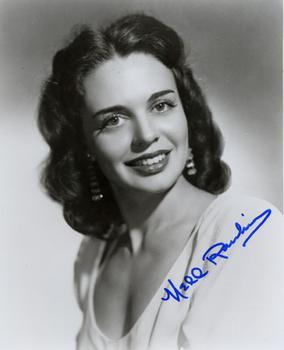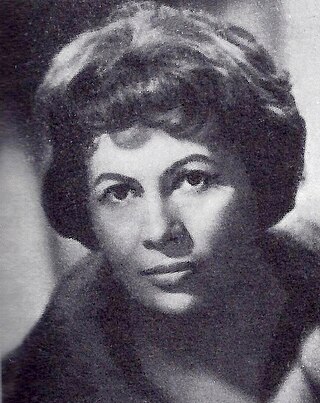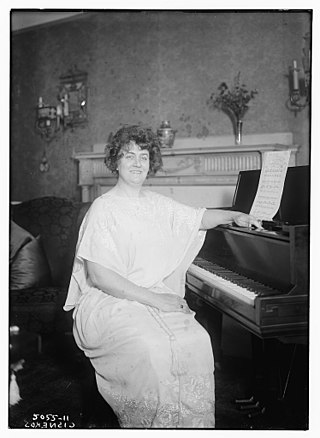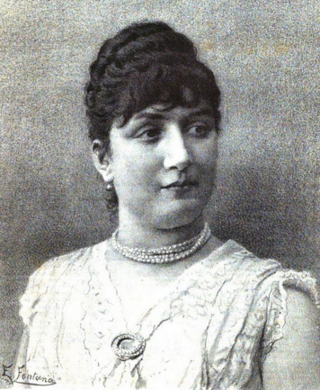
Nell Rankin was an American operatic mezzo-soprano. Though a successful opera singer internationally, she spent most of her career at the Metropolitan Opera, where she worked from 1951 to 1976. She was particularly admired for her portrayals of Amneris in Verdi's Aida and the title role in Bizet's Carmen. Opera News said, "Her full, generous tone and bold phrasing, especially in the Italian repertory, were unique among American mezzos of her generation.
Ebe Stignani was an Italian opera singer, who was pre-eminent in the dramatic mezzo-soprano roles of the Italian repertoire during a stage career of more than thirty years.

Herva Nelli was an Italian-American operatic soprano.
Dolora Zajick is an American mezzo-soprano opera singer who specializes in the Verdian repertoire. Zajick has been described as having "one of the greatest voices in the history of opera".

Biserka Cvejić was a Serbian operatic mezzo-soprano and contralto, and a university professor of Croatian descent. Her career began at the Belgrade Opera in 1954. She was a member of the Vienna State Opera from 1959 to 1979, performing internationally. She first appeared at the Metropolitan Opera in 1961 as Amneris in Verdi's Aida, returning in many more leading roles of the Italian and French repertoire.

Irina Petrovna Bogacheva was a Russian mezzo-soprano at the Mariinsky Theatre and a professor of voice at the Saint Petersburg Conservatory. Trained in Leningrad and at La Scala in Milan, she performed leading roles of the Russian and Italian repertoire at major international opera houses. Dmitry Shostakovich composed a song cycle to poems of Marina Tsvetaeva for her.
Ivanka Ninova is a Bulgarian mezzo-soprano opera singer born in Vidin.

Eleonora de Cisneros was an American opera singer. She was a singer for the Metropolitan Opera company and became one of their principal singers. She was the first American-trained opera singer hired by the Metropolitan Opera company. During the early twentieth century, she performed at major opera houses in the United States, Cuba, Europe, Australia, New Zealand, South America and Russia.
Lauris Margaret Elms is an Australian retired contralto, renowned for her roles in opera and lieder and as a recording artist.

Giulia Novelli was an Italian operatic mezzo-soprano.

Milijana Nikolic is an operatic mezzo-soprano.
Bernadette Eileen Cullen is an Australian dramatic mezzo-soprano who has performed in Australia, Europe, and Asia.

Dragana Radakovic is an operatic soprano, conductor and academic. With a flexible voice, she is able to sing bel canto as well as dramatic soprano roles. She has appeared at major opera houses in title and leading roles, including Bellini's Norma, Verdi's Aida, and Puccini's Turandot.
Grace Hoffman was an American operatic mezzo-soprano and academic teacher. Based at the Staatsoper Stuttgart from 1955 to 1992, she performed roles such as Verdi's Azucena and Eboli at leading opera houses in Europe and the Americas. Her signature role was Wagner's Brangäne, performed at the Bayreuth Festival, among others.
Ekaterina Semenchuk, is a Belarusian operatic mezzo-soprano.

Tichina Vaughn is an American operatic dramatic mezzo-soprano active internationally in opera, concert halls and recitals. Starting at the Lindemann Young Artist Development Program at the Metropolitan Opera, her American career expanded into Europe, as member of the permanent ensembles of the Semperoper in Dresden and the Stuttgart Opera, where she was awarded the title of Kammersängerin in 2006. She has been a regular at the Arena di Verona and other major theaters worldwide, singing a wide repertoire span, with a "voluminous and dark mezzo" voice the dramatic Verdi roles such as Amneris in Aida, Eboli in Don Carlo, Azucena in Il trovatore and Ulrica in Un ballo in maschera, Wagner's Ortrud Lohengrin, Venus Tannhäuser, Fricka Die Walküre, Waltraute in Götterdämmerung and Strauss, Herodias in Salome and Klytemnestra in Elektra. According to Opernglas, Vaughn has a natural "great intensity" on stage, with an ample "voice, which flows richly, even in the low registers." The Neue Zürcher Zeitung describes her voice as an "enchanting satisfyingly rich mezzosoprano". Bernard Holland of The New York Times called hers "A voice of quality", which had "the presence and personality that might well fit the Met... a mezzo-soprano whose strong upper register gave hints of a dramatic soprano to come".
Marianne Cornetti is an American opera singer, known for her rendition of mezzo-soprano roles in operas by Giuseppe Verdi, such as Azucena in Il trovatore, Amneris in Aida, and Eboli in Don Carlo.

Agnieszka Rehlis is a Polish operatic mezzo-soprano who has made an international career. She is known for portraying Verdi characters including Amneris and Azucena. She participated in music by Krzysztof Penderecki, including the world premiere of his Eighth Sinfonie and the Grammy Award–winning collection Penderecki Conducts Penderecki.

Agnes Sofia Charlotta Janson, married name Fischer, (1861–1947) was a Swedish mezzo-soprano opera singer and recitalist who later moved to Australia. After making her debut in April 1883 at the Royal Swedish Opera as Azucena in Verdi's Il trovatore, she remained with the company until 1885. Thereafter she sang mainly in recitals, principally in the United Kingdom but also in the major concert halls of Europe. In 1906, she settled in Australia, where she taught voice at the Melbourne Conservatory until her retirement in 1927.
Elena Manistina is a Russian operatic mezzo-soprano. She is a member of the Bolshoi Theatre and has appeared in many operas internationally. She also appeared as Verdi's Azucena at the Metropolitan Opera, the Deutsche Oper Berlin and Opéra Bastille, and as Amneris at the Arena di Verona.











